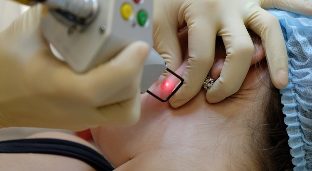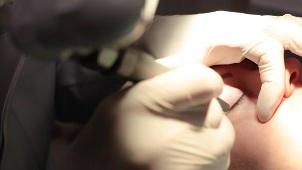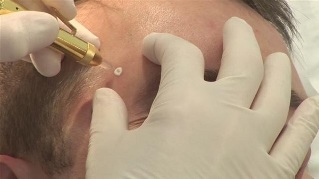
Laser removal of neoplasms is a very common and effective procedure that helps to get rid of unwanted growth. This is a relatively new method that has only recently emerged in the medical arsenal, but has managed to prove its superiority over other methods. The first methods of laser destruction were removed using liquid nitrogen, electricity, or a scalpel. All this can cause a lot of inconvenience to the patient, and laser removal gives good results with painless intervention.
Why remove
Papillomas, which come in all shapes and sizes, are often malignant tumors. They are localized in the mucous membranes of the wearer or his skin. The main reason for their appearance is the effect of human papillomavirus, most often sexually transmitted.
Removing these structures performs several tasks at once:
- Aesthetic correction.A patient with long hair may be uncomfortable with paying too much attention to others. As a result, a person may feel insecure and uncomfortable, even if he does not pose a threat.
- Injury prevention.If the growth is in a traumatic area where the patient is constantly in contact with it, it can lead to the separation of the protruding part. In addition, trying to cover the papilloma with clothing can cause problems such as wiping the affected area. This can lead to papilloma injury and subsequent infection. Damage can lead to microbial absorption and inflammation of the wound. If this happens, treat the affected area with peroxide, go to the clinic immediately and remove the rest of the papilloma.
- Reducing the risk of cancer.Despite the fact that plants are good in nature, they have different manifestations, such as condyloma. They are usually located nearby and pose a significant risk of developing cancer. To prevent the disease, the warts must be removed.
Do not remove growths on your own. Attempts to tie a papilloma with a string, comb, or apply a chemical to it can worsen its condition.
Advantages of the procedure
Laser removal has several advantages over other methods.These include:
- Guaranteed result.With the help of a laser, the excretion is completely eliminated, leaving nothing even in the deep layers under the skin. The device can go deep to clear the remaining traces of neoplasm.
- No pain.The effect of the laser gives the patient minimal pain. If you add local anesthetics and anesthesia to the procedure, there is no pain.
- Speed of the procedure. Laser removal of papillomas takes 2-5 minutes per element.
- is not invasive.The laser beam is in a limited area and does not extend beyond it. In this case, more than one part of the laser does not touch the site of the procedure. This is important because this method helps to reduce the risk of infection and provides a high guarantee of sterility.
- No postoperative scars.If the work is done correctly, there should be no traces of laser exposure at the exposure site. This is because the damaged tissue completely evaporates and then a new, whole skin takes its place.
- A bloodless way to destroy.The laser light heats up the capillaries that supply blood and closes their walls quickly. As a result, the bleeding stops and does not recover after surgery.
- Suitable for different parts of the body.Not all removal methods are used on every part of the body. Intimate areas, eyelids, etc. are considered particularly sensitive. Due to the accuracy of the laser beam, laser removal of growth in such areas works well.
All of these factors make laser hair removal one of the most sought after growth removal procedures.
Contraindications
The list of contraindications to this procedure is not as long as other methods of elimination.Among those who have banned laser removal are:
- diabetes mellitus;
- oncology;
- exacerbation of chronic diseases;
- seizures;
- diseases associated with problems of the endocrine system;
- poor blood clotting;
- HIV or AIDS;
- Acute inflammatory diseases.
In addition, patients with recent flu or acute respiratory infections should postpone the procedure.
Description of the procedure
Before starting the growth procedure, the doctor will disinfect the area where the operation will be performed. In some cases, local anesthesia is used to relieve pain. Usually an oil or spray is used for this. 2-3 minutes after taking the anesthetic, the removal process begins.

The laser beam is focused on the affected area and prevents unwanted growth. At this point, the substances in the cells evaporate under the influence of the laser, removing every layer of damaged tissue. This is not just in easily accessible places in the open. The procedure for removing a papilloma, for example, from the eyelid is the same. The only nuance of this area is that a special cooling method is used for the patient to prevent pain and burns in this sensitive area.
Neoplasms in intimate areas are removed according to the same principle. But here the doctor usually injects as an anesthetic and injects growth in all directions.
The injection may be a little painful, but after a minute or two the sensitivity in the affected area disappears completely, and further manipulations do not hurt at all.
The affected area becomes a small bloodless wound. In its absence, it is disinfected by the action of a laser. After the dryness is removed, the doctor treats the affected area with potassium permanganate.
After the procedure, the patient may experience slight redness, itching, or mild pain at the site of papilloma removal.
This reaction is considered normal because, despite the non-invasive nature of the procedure, there was interference with the integrity of the skin during the operation.All discomfort should disappear completely 2-4 days after the procedure.
Later, a dry crust forms on the wound. There is already a layer of healthy skin under it, so its protective membrane cannot be removed until it falls off. Otherwise, the scar will remain on the skin and the recovery process itself may take longer.
Results
Complications after laser removal are rare. As a rule, their presence is due to the patient's previous illnesses, which he did not cure before the procedure. Thus, for example, if a patient has skin inflammation, it may cause pigmentation. If the skin itself is very sensitive, there may be some redness due to the burn. With a high allergic reaction, swelling may occur at the site of exposure.
To rule out all side effects, you should consult a doctor before performing laser resurfacing.
Post-procedure care
After removing the enclosure, the patient should follow these rules:
- Water should not enter the wound for 2-3 days;
- Avoid saunas, baths and swimming pools;
- Do not wipe the affected area with a towel;
- Do not apply plaster to the wound;
- Do not treat papilloma removal with scrubs or alcohol-based lotions;
- Avoid exposure to ultraviolet light.
The citizen should be treated with antiseptic several times a day. This should be done before the scab separates. This treatment helps prevent infection and speed up the full recovery time.You can drink a solution of iodine or potassium permanganate to treat the affected area.
The removed area can be treated with anti-inflammatory ointments.
Their efforts are aimed at accelerating tissue regeneration, reducing inflammation and swelling. Before choosing a particular remedy, it is best to consult a doctor.
Which method is better
Laser removal is not the only way to combat unwanted growth. There are other ways, including:

Cryodestruction.
Based on the removal of papillomas with liquid nitrogen. Under the influence of low temperatures, the concentration collapses and eventually disappears completely. The method is effective, but has several drawbacks. Among them, it is impossible to fully control the depth of exposure to nitrogen. The substance may touch a healthy area and penetrate very deeply, or, conversely, act only superficially and do not affect all layers of the localization of the construction site.
In addition, this method is characterized by:
- the possibility of postoperative scars;
- painful feelings;
- Failure to guarantee results after the first procedure.
Thus, laser destruction is more effective than cryodestruction. Laser removal is less painful and guarantees the desired result.
Removal of radio waves.
This method of destruction is carried out with the help of a special device that affects the papilloma by radio waves. This causes the accumulated object to intersect due to the harmful effects of the knife. The accuracy of the procedure is very high, so as not to damage the surrounding tissues. However, the risk of burns or infection is very low.
This method is suitable for removing small harmless areas. It is highly effective which has made it as popular as laser removal. Both methods are considered modern methods of removing papillomas and are used equally in medicine.

Electrocoagulation.
This method is based on the action of a high-frequency electric current that operates directly on the affected area of the papilloma. Electrocoagulation is now considered a common but outdated method. This method allows you to prevent bleeding after burning the vessels and removing the papilloma.
However, when using high-frequency current, patients still experience pain after anesthesia. This has led some patients to opt for laser ablation as a more advanced and painless method and to abandon electrotherapy.
Estimated cost
The price range depends not only on the area and clinic where the removal is performed, but also on the number, size and location of the plants obtained.
Many clinics offer discounts on wholesale removal of neoplasms: the more patients, the cheaper it is to remove a growth.
Getting rid of genital growth can be more expensive than other parts of the body. Moreover, due to the complexity of such manipulation, not every clinic provides such services.














































































